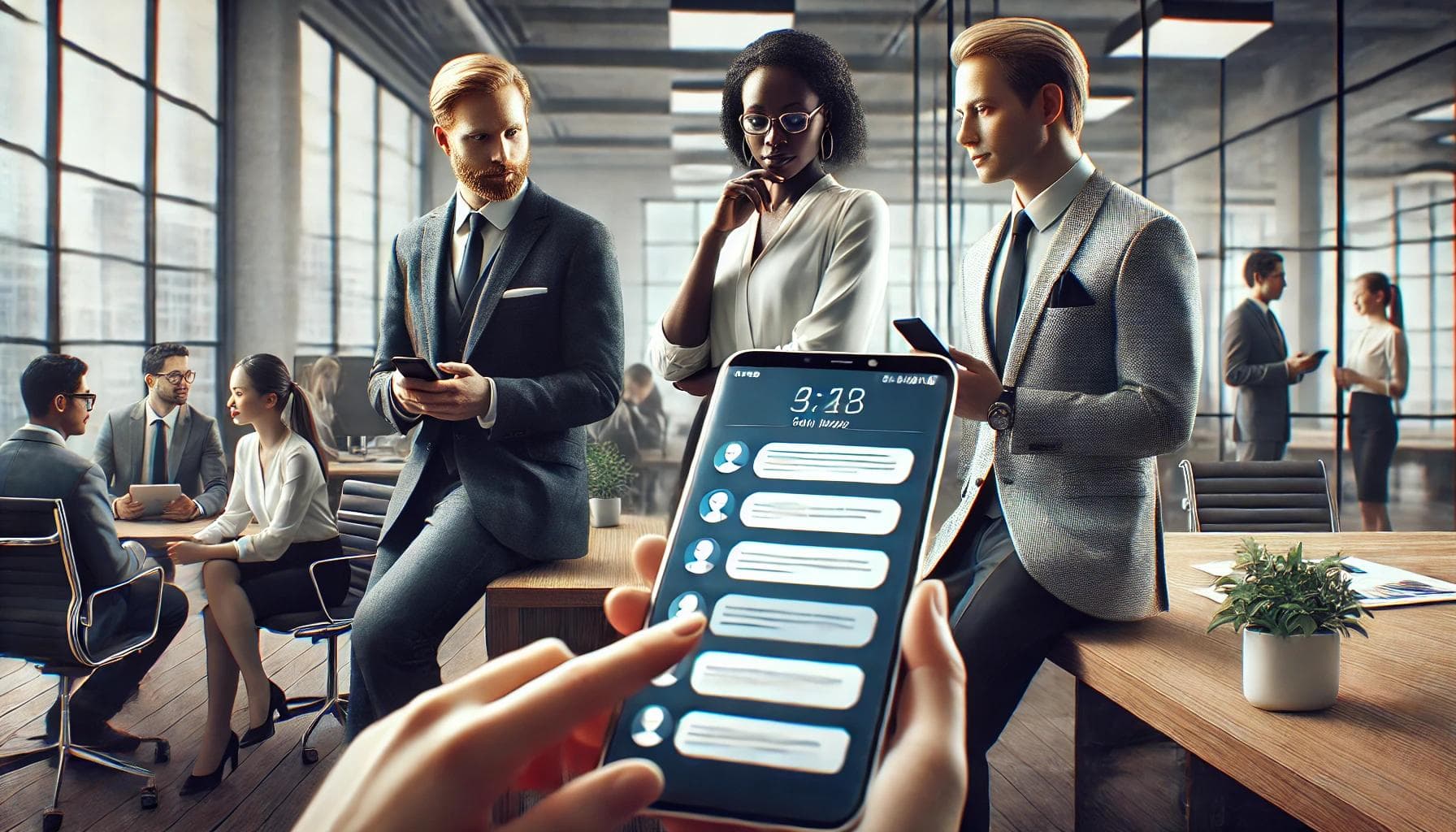Table of Contents
- 1. The Importance of Professional Texting Etiquette
- 2. General Rules for Professional Texting
- 3. Office Texting Etiquette for Staff
- 4. Students Texting Etiquette Entering the Professional World
- 5. Cultural Sensitivity and Global Considerations
- 6. Legal and Compliance Issues
- 7. Enhancing Professional Relationships Through Texting
- 8. Integrating Texting with Other Communication Channels
- 9. Advanced Tips and Best Practices
- Conclusion
Try Whippy for Your Team
Experience how fast, automated communication drives growth.

Once a casual form of communication, messaging has become essential in professional settings. Whether you're managing projects or entering the workforce, mastering proper etiquette is key. This guide offers practical tips to help you communicate effectively and leave a positive impression.
In a world where first impressions often happen over a screen, how you text can make or break professional relationships. Let's explore how to navigate this digital communication landscape with finesse and professionalism.
1. The Importance of Professional Texting Etiquette
1.1 The Rise of Texting in Corporate Communication
Texting has become an indispensable tool in corporate communication. According to a 2023 study by Business Communications Today, 85% of professionals use texting for business purposes, a significant increase from previous years. This shift is attributed to the need for immediate responses, remote work trends, and the ubiquity of mobile devices.
Case Study: A multinational corporation implemented a texting platform for internal communication, resulting in a 30% increase in response rates, and a 25% reduction in email overload.
Texting offers:
- Immediate Connectivity: Instant communication regardless of location.
- High Open Rates: Text messages boast a 98% open rate, compared to 20% for emails.
- Enhanced Collaboration: Facilitates quick decision-making and problem-solving.
1.2 Potential Risks of Improper Texting
Despite its advantages, improper texting can lead to:
- Miscommunication: Lack of tone and context can cause misunderstandings.
- Professionalism Issues: Casual language or slang may be deemed unprofessional.
- Legal Consequences: Mishandling confidential information can lead to compliance breaches.
Example: An employee accidentally sent sensitive company information through an unsecured message, causing a data leak and legal trouble for the company.
1.3 Benefits of Mastering Texting Etiquette
Mastering texting etiquette can:
- Enhance Clarity: Clear messaging reduces the risk of misunderstandings.
- Build Professional Relationships: Proper etiquette reflects respect and professionalism.
- Boost Efficiency: Streamlined communication saves time and resources.
Expert Opinion: "In today's digital age, how you communicate is as important as what you communicate. Professional texting etiquette is essential for maintaining corporate integrity and efficiency." — Dr. Emily Roberts, Communications Specialist.
2. General Rules for Professional Texting
2.1 Be Clear and Concise
Professional texting guidelines emphasize the importance of clarity. Avoid jargon and keep messages straightforward.
Tips:
- Stick to One Subject: Focus on a single topic per message.
- Use Bullet Points: For longer messages, structure information with bullet points.
- Avoid Ambiguity: Be specific to prevent misinterpretation.
Example: Instead of "Can we reschedule our meeting?", specify "Can we reschedule our meeting to Thursday at 2 PM?"
2.2 Use Proper Grammar and Punctuation
Maintaining proper texting etiquette involves using correct grammar and punctuation to convey professionalism.
Guidelines:
- Avoid Text Speak: Refrain from using abbreviations like "u" for "you."
- Proofread Messages: Check for typos and grammatical errors.
- Use Appropriate Capitalization: Avoid typing in all caps, which can be perceived as shouting.
Example: "Please review the attached report and let me know your feedback by end of day."
2.3 Timing is Everything: Respect Work Hours
Adhering to business texting etiquette means sending messages during appropriate hours to respect recipients' time.
Best Practices:
- Know Recipient's Time Zone: Be mindful of global colleagues.
- Urgent Matters Only After Hours: If necessary, acknowledge the inconvenience.
- Schedule Messages: Use tools to send messages during appropriate hours.
Example: "Apologies for the late message; I wanted to ensure you have the updated figures for tomorrow's meeting."
2.4 Confidentiality and Security Considerations
Ensure messages comply with company policies and data protection laws, a key aspect of SMS communication best practices.
Recommendations:
- Use Secure Platforms: Utilize company-approved messaging apps with encryption.
- Avoid Sharing Sensitive Information: Do not send confidential data over text.
- Confirm Recipient Identity: Ensure you are texting the correct person, especially when discussing sensitive topics.
Scenario: Before sending a confidential update, double-check the recipient's number and ensure the platform is secure.
3. Office Texting Etiquette for Staff
3.1 Coordinating with Team Members
Use clear subject lines and direct language to facilitate effective collaboration.
Strategies:
- Set Clear Expectations: Define response times and availability.
- Use Group Chats Appropriately: Only include relevant team members.
- Acknowledge Messages: Even a simple "Got it, thanks!" confirms receipt.
Example: "Team, please review the updated project plan by EOD Friday. Let me know if you have any questions."
3.2 Communicating with Superiors and Subordinates
Maintain a respectful tone, aligning with professional text message etiquette standards.
With Superiors:
- Be Respectful: Use formal language unless advised otherwise.
- Provide Context: Briefly explain the purpose of the message.
- Be Considerate of Their Time: Keep messages succinct.
Example to Superior: "Good morning, I wanted to update you that the client approved the proposal. Shall we schedule a meeting to discuss next steps?"
With Subordinates:
- Be Clear and Direct: Provide precise instructions.
- Offer Support: Encourage questions and provide guidance.
- Maintain Professional Tone: Avoid overly casual language.
Example to Subordinate: "Please prioritize the data analysis report and have it ready by Wednesday. Let me know if you need any assistance."
3.3 Texting Clients and External Partners
Personalize messages appropriately, reflecting corporate texting etiquette norms.
Guidelines:
- Obtain Consent: Ensure they are comfortable communicating via text.
- Personalize Messages: Address them by name and reference previous interactions.
- Maintain Formality: Keep the tone professional, especially in initial communications.
Example: "Hello Mr. Smith, this is Jane from XYZ Corp. I'm reaching out to confirm our meeting scheduled for next Tuesday at 10 AM."
3.4 Managing Group Texts and Notifications
Implement group texting etiquette by setting clear guidelines for group communications to avoid overwhelming participants. Proper group text message etiquette includes limiting unnecessary replies, clearly defining group purpose, and respecting everyone's time. If you're unsure about the best approach, learn about the differences between mass texting and group MMS.
Best Practices:
- Limit Group Size: Include only necessary participants.
- Set Guidelines: Establish norms for group communication.
- Use Threads: If the platform allows, keep conversations organized.
Tip: Encourage team members to mute notifications during non-work hours to respect personal time.
4. Students Texting Etiquette Entering the Professional World
4.1 Transitioning from Casual to Professional Communication
Students should adapt to professional texting etiquette by avoiding slang and using formal language.
Advice:
- Adopt Formal Language: Use full sentences and avoid slang.
- Introduce Yourself: In initial communications, provide context about who you are.
- Mirror the Professional Tone: Observe and emulate the communication style of colleagues.
Example: "Hello, I'm Alex Johnson, the new intern in the marketing department. I look forward to working with you."
4.2 Networking and First Impressions via Text
First impressions matter; adhere to text message etiquette to convey professionalism.
Strategies:
- Be Polite and Respectful: Use courteous language and greetings.
- Reference Common Connections: Mention how you obtained their contact.
- State Your Purpose Clearly: Explain why you're reaching out.
Example: "Good afternoon, Dr. Lee. I'm a recent graduate from ABC University, and Professor Smith suggested I contact you regarding opportunities in environmental engineering."
4.3 Internships and Job Communication
Follow professional texting guidelines when communicating with potential employers or colleagues.
Tips:
- Respond Promptly: Timely replies show enthusiasm and reliability.
- Confirm Details: Clarify dates, times, and locations to prevent confusion or mistakes.
- Express Gratitude: Thank contacts for their time and assistance.
Example: "Thank you for the opportunity to interview for the junior analyst position. I look forward to our meeting on Friday at 2 PM."
4.4 Avoiding Common Mistakes
Be mindful of tone and content to maintain texting manners etiquette.
Common texting pitfalls for students include:
- Overusing Emojis: Limit or avoid emojis in professional contexts.
- Being Too Casual: Refrain from using slang or informal phrases.
- Ignoring Formalities: Use appropriate salutations and closings.
Example of What to Avoid: "Hey, what's up? Can't wait to start the new gig! 😊"
5. Cultural Sensitivity and Global Considerations
5.1 Understanding International Communication Norms
Keep in mind that business text etiquette varies across cultures, so be sure to adapt accordingly.
Considerations:
- Time Zones: Be mindful of local times to avoid disturbing recipients.
- Language Barriers: Use clear, simple language to aid understanding.
- Cultural Etiquette: Research cultural norms, including which phrases or gestures are appropriate.
Example: In some cultures, direct language is preferred, while in others, a more indirect approach is respectful.
5.2 Emojis and Emoticons: When Are They Appropriate?
Use emojis sparingly and appropriately, considering professional text message etiquette.
Guidelines:
- Know Your Audience: Use emojis only if appropriate in your professional environment.
- Limit Usage: If used, keep it minimal and relevant.
- Understand Meanings: Be aware that emojis can have different interpretations across cultures.
Example: A thumbs-up emoji may be positive in some cultures but offensive in others.
6. Legal and Compliance Issues
6.1 Company Policies on Texting
Familiarize yourself with organizational policies to ensure proper texting etiquette.
Actions:
- Review Company Guidelines: Understand expectations and restrictions.
- Attend Training Sessions: Participate in any offered communication training.
- Seek Clarification: When in doubt, consult HR or a supervisor.
6.2 Record-Keeping Requirements
Maintain records of communications as part of SMS communication best practices.
Best Practices:
- Use Official Channels: Employ company-approved messaging platforms that archive messages.
- Avoid Deleting Messages: Maintain records as per company policy.
- Be Aware of Legal Obligations: Understand any industry-specific regulations.
Example: Financial institutions often have strict requirements for retaining communications.
6.3 Personal Data Protection
Protecting sensitive information is essential in business texting etiquette standards. Healthcare professionals, in particular, should be aware of the strict guidelines for HIPAA-compliant texting.
Recommendations:
- Avoid Sharing Personal Information: Do not transmit personal data over unsecured texts.
- Encrypt Messages: Use platforms that offer encryption.
- Stay Informed: Keep abreast of data protection laws like GDPR or HIPAA.
7. Enhancing Professional Relationships Through Texting
7.1 Building Rapport
Personalize messages to strengthen professional connections, adhering to professional texting guidelines. Consider using automated messaging strategies for first-time guests to deliver a memorable first impression.
Strategies:
- Personal Touches: Acknowledge personal milestones if appropriate.
- Positive Language: Use encouraging words to foster goodwill.
- Active Listening: Show engagement by referencing previous conversations.
Example: "Congratulations on your promotion! Looking forward to collaborating on new projects."
7.2 Conflict Resolution
Address issues promptly and respectfully, in line with texting manners etiquette.
Approach:
- Remain Calm: Keep emotions in check when texting.
- Seek Clarity: Ask questions to understand the other party's perspective.
- Suggest a Call or Meeting: Complex issues are often better resolved verbally.
Example: "I understand your concerns. Perhaps we can discuss this further over a call to find a solution."
7.3 Providing Feedback
Offer constructive feedback through text, maintaining proper texting etiquette.
Guidelines:
- Be Specific: Provide clear examples.
- Maintain Professional Tone: Keep language neutral and focused on the issue.
- Offer Support: Suggest ways to improve or assist.
Example: "The report was comprehensive; however, including the latest market data could strengthen our proposal. Let me know if you need help accessing those resources."
8. Integrating Texting with Other Communication Channels
8.1 Balancing Emails, Calls, and Texts
Choose the appropriate medium for your message, considering SMS communication best practices.
Recommendations:
- Use Texting for Urgent Matters: Quick updates or confirmations.
- Reserve Emails for Detailed Information: Long-form communication with attachments.
- Opt for Calls for Complex Discussions: Nuanced topics that benefit from vocal tone.
Example: Send a text to confirm a meeting time, an email to provide the agenda, and a call to discuss strategic decisions.
8.2 Choosing the Right Medium for Your Message
Assess the nature of the message to determine if texting is suitable, aligning with professional texting etiquette.
Considerations:
- Audience Preference: Some clients may prefer emails over texts.
- Message Sensitivity: Confidential or sensitive information may require secure channels.
- Documentation Needs: Emails provide a formal record when needed.
9. Advanced Tips and Best Practices
9.1 Personalizing Messages Without Losing Professionalism
Balance personalization with formality, adhering to corporate texting etiquette.
Tips:
- Use the Recipient's Name: Adds a personal touch.
- Reference Past Interactions: Shows attentiveness.
- Express Genuine Interest: In their projects or well-being.
Example: "Hi Sarah, great job on the presentation last week. Your insights on market trends were particularly valuable."
9.2 Leveraging Texting Tools and Features
Utilize tools that support office texting etiquette, such as scheduling messages or landline texting platforms. Explore more about the benefits of landline texting for businesses to enhance customer engagement.
Utilize:
- Read Receipts: To confirm message delivery and reading.
- Scheduling Messages: To send messages at optimal times.
- Organizing Chats: Use labels or folders for different projects.
Caution: Ensure the use of these features complies with company policies.
9.3 Continual Learning and Adaptation
Adapt to shifting text etiquette norms to keep your communication effective.
Actions:
- Stay Updated: Follow industry blogs and updates on communication tools.
- Seek Feedback: Ask colleagues for input on your communication style.
- Adapt to New Norms: Be open to adopting new practices as they emerge.
Conclusion
Mastering corporate texting etiquette is a dynamic process that requires awareness, adaptability, and continual learning. Following the guidelines in this guide can improve your professional image, strengthen relationships, and help you communicate better in the digital workplace.
✅ Remember, every text you send is a reflection of your professionalism. Make each one count. If you're ready to take your business texting to the next level, schedule a demo with Whippy to explore advanced texting solutions.
Table of Contents
Table of Contents
- 1. The Importance of Professional Texting Etiquette
- 2. General Rules for Professional Texting
- 3. Office Texting Etiquette for Staff
- 4. Students Texting Etiquette Entering the Professional World
- 5. Cultural Sensitivity and Global Considerations
- 6. Legal and Compliance Issues
- 7. Enhancing Professional Relationships Through Texting
- 8. Integrating Texting with Other Communication Channels
- 9. Advanced Tips and Best Practices
- Conclusion
Try Whippy for Your Team
Experience how fast, automated communication drives growth.
Related Articles

Top AI Recruiter Agents for 24/7 Speed-to-Lead

How Recruiters Work Side-by-Side with an AI Recruiter

Voice AI Recruiter for Staffing Teams

AI Recruitment ROI: How Staffing Firms Save Time & Money

Recruitment Compliance Automation with AI
